Python的try... excep异常捕捉机制
- 一、没有加入异常捕捉机制
- 二、加入try ... except 异常捕捉
- 1、已知错误类型 (例如下面已知列表索引错误类型`IndexError`)
- 2、未知异常的类型
- 三、try ... except ... else ... finally 使用
- 四、logging模块调用异常捕捉方法,保存异常信息日志
- 2、例子
- 五、常用的异常类型表
异常:
异常即非正常状态,在Python中使用异常对象来表示异常。若程序在编译或运行过程中发生错误,程序的执行过程就会发生改变,抛出异常对象,程序流进入异常处理。如果异常对象没有被处理或捕捉,程序就会执行回溯(Traceback)来终止程序。
1、发生异常,不做处理:
def test_expect():
ll = ["one", "two", "three"]
print(ll[3])
if __name__ == '__main__':
test_expect()
错误异常信息如下:
Traceback (most recent call last):
File "D:/ZF/1_ZF_proj/python跳过异常继续执行.py", line 80, in <module>
test_expect()
File "D:/ZF/1_ZF_proj/python跳过异常继续执行.py", line 67, in test_expect
print(ll[3])
IndexError: list index out of range
2、使用try…except没有发生异常
def test_expect():
ll = ["one", "two", "three"]
try:
print("没有发生异常:------------------")
print(ll[2])
print("发生异常,这里不执行:************")
except Exception as e:
print("只有try中发生异常,except才会执行")
if __name__ == '__main__':
test_expect()
没有发生异常输出结果如下(只要没有发生异常,except中的语句就不会被执行):
D:software_installAnaconda_installpython.exe D:/ZF/1_ZF_proj/python跳过异常继续执行.py
没有发生异常:------------------
three
发生异常,这里不执行:************
3、使用try…except发生异常
def test_expect():
ll = ["one", "two", "three"]
try:
print("没有发生异常:------------------")
print(ll[6])
print("发生异常,这里不执行:************")
except Exception as e:
print("只有try中发生异常,except才会执行")
if __name__ == '__main__':
test_expect()
发生异常输出结果如下(只要发生异常,就会从try发生异常的位置,跳到except语句中执行):
D:software_installAnaconda_installpython.exe D:/ZF/1_ZF_proj/python跳过异常继续执行.py
没有发生异常:------------------
只有try中发生异常,except才会执行
4、查看异常信息的输出
一、没有加入异常捕捉机制
test_list = [1, 2]
print(test_list[3])
执行之后,会在控制台输出:IndexError 错误, 意思是超过了列表的索引范围
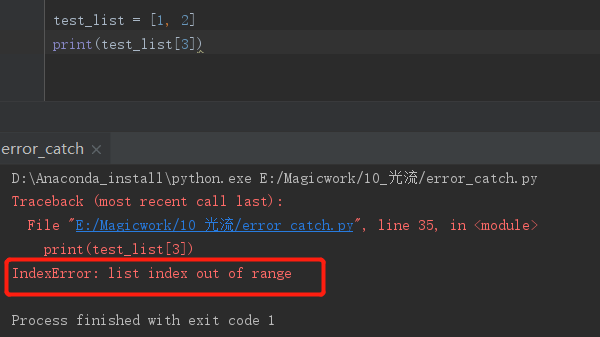
二、加入try … except 异常捕捉
1、已知错误类型 (例如下面已知列表索引错误类型IndexError)
下面以一个列表索引的例子来讲述 try... except的用法
1、异常类型起别名
import logging
logging.basicConfig(level=logging.INFO,
filename='Error.log',
format='%(asctime)s - %(message)s')
test_list = [1, 2]
try:
print(test_list[2])
except IndexError as e:
logging.error("索引越界:%s" % e)
我们知道捕捉的异常类型是IndexError 测试可以直接在except后面加上异常类型
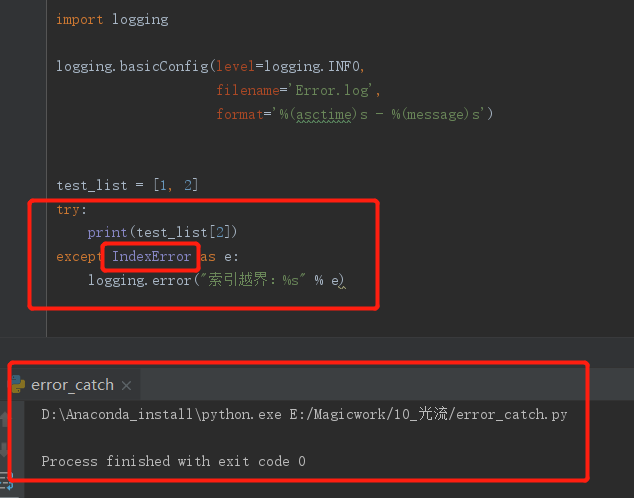
在日志中保存捕捉的异常信息,Error.log 中保存的异常信息如下:
2019-04-18 14:24:19,109 - 索引越界:list index out of range
2、异常类型不起别名
import logging
logging.basicConfig(level=logging.INFO,
filename='Error.log',
format='%(asctime)s - %(message)s')
test_list = [1, 2]
try:
print(test_list[2])
except IndexError:
logging.error("索引越界:%s" % IndexError)
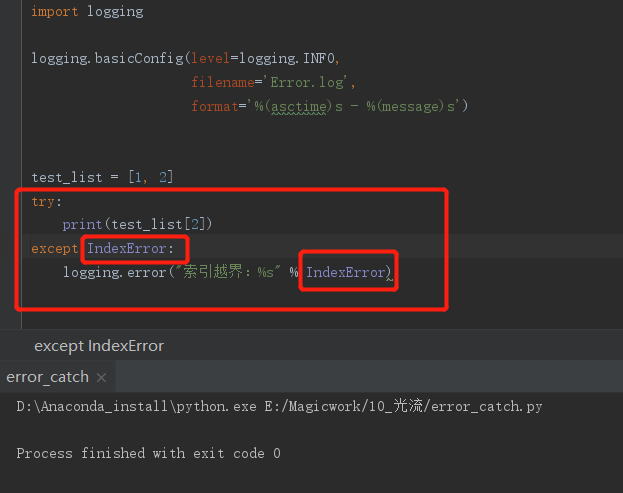
在日志中保存捕捉的异常信息,Error.log 中保存的异常信息如下:
2019-04-18 14:36:47,177 - 索引越界:<class 'IndexError'>
3、把异常的类型和错误信息都输出
import logging
logging.basicConfig(level=logging.INFO,
filename='Error.log',
format='%(asctime)s - %(message)s')
test_list = [1, 2]
try:
print(test_list[2])
except IndexError as e:
logging.error("索引越界:%s" % IndexError) # 输出错误的类型
logging.error("索引越界:%s" % e) # 输出错误的信息
在日志中保存捕捉的异常信息,Error.log 中保存的异常信息如下:
2019-04-18 14:39:11,863 - 索引越界:<class 'IndexError'>
2019-04-18 14:39:11,863 - 索引越界:list index out of range
2、未知异常的类型
有些异常类型可能我们在事先之前并不知道,应该步捕捉呢,此时可以用 Exception 代替未知的异常类型,也就是Exception 和 IndexError其实就是等价的啦,只是我们看代码没有明显说明是什么异常类型而已
举例:
import logging
logging.basicConfig(level=logging.INFO,
filename='Error.log',
format='%(asctime)s - %(message)s')
test_list = [1, 2]
try:
print(test_list[2])
except Exception as e:
logging.error("索引越界:%s" % IndexError)
logging.error("索引越界:%s" % e)
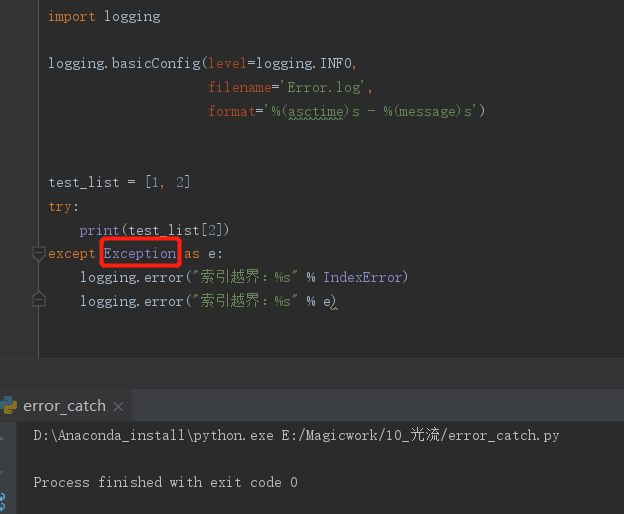
在日志中保存捕捉的异常信息,Error.log 中保存的异常信息如下:
2019-04-18 14:50:49,419 - 索引越界:<class 'IndexError'>
2019-04-18 14:50:49,419 - 索引越界:list index out of range
三、try … except … else … finally 使用
try:
except:
else: 只有不发生异常才会执行
finally: 无论是否发生异常都会执行
import logging
logging.basicConfig(level=logging.INFO,
filename='Error.log',
format='%(asctime)s - %(message)s - %(module)s.py')
test_list = [1, 2]
try:
print(test_list[3])
except Exception as e:
logging.error("索引越界:%s" % IndexError)
logging.error("索引越界:%s" % e)
else:
logging.info("只有不发生异常才会执行") # 程序不报错才会执行
finally:
logging.info("无论是否发生异常都会执行") # 程序报不报错都会执行
print("捕捉到错误,这里也是会执行的")
把异常的信息记录到日志中,之后下面的代码还会继续执行
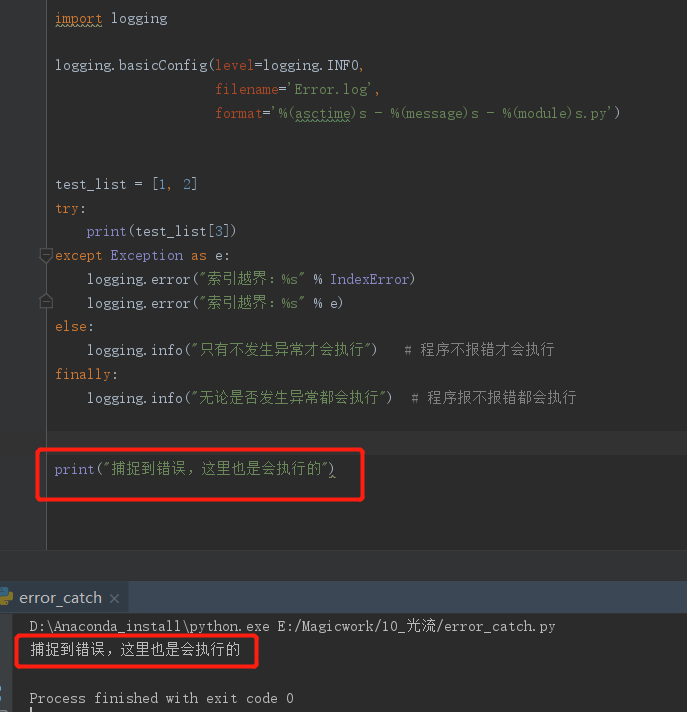
在日志中保存捕捉的异常信息,Error.log 中保存的异常信息如下:
2019-04-18 19:06:26,820 - 索引越界:<class 'IndexError'> - error_catch.py
2019-04-18 19:06:26,821 - 索引越界:list index out of range - error_catch.py
2019-04-18 19:06:26,821 - 无论是否发生异常都会执行 - error_catch.py
四、logging模块调用异常捕捉方法,保存异常信息日志
logging模块,有两个方法可以直接保存异常的日志信息
- logging.error()
- logging.exception()
两个方法的文档:
def error(msg, *args, **kwargs):
"""
Log a message with severity 'ERROR' on the root logger. If the logger has
no handlers, call basicConfig() to add a console handler with a pre-defined
format.
"""
if len(root.handlers) == 0:
basicConfig()
root.error(msg, *args, **kwargs)
def exception(msg, *args, exc_info=True, **kwargs):
"""
Log a message with severity 'ERROR' on the root logger, with exception
information. If the logger has no handlers, basicConfig() is called to add
a console handler with a pre-defined format.
"""
error(msg, *args, exc_info=exc_info, **kwargs)
2、例子
import logging
logging.basicConfig(level=logging.INFO,
filename='Error.log',
format='%(asctime)s - %(message)s - %(module)s.py')
test_list = [1, 2]
try:
print(test_list[2])
except Exception as e:
logging.error(e)
logging.info("----------------------------------------")
logging.exception(e)
print("捕捉到错误,这里也是会执行的")
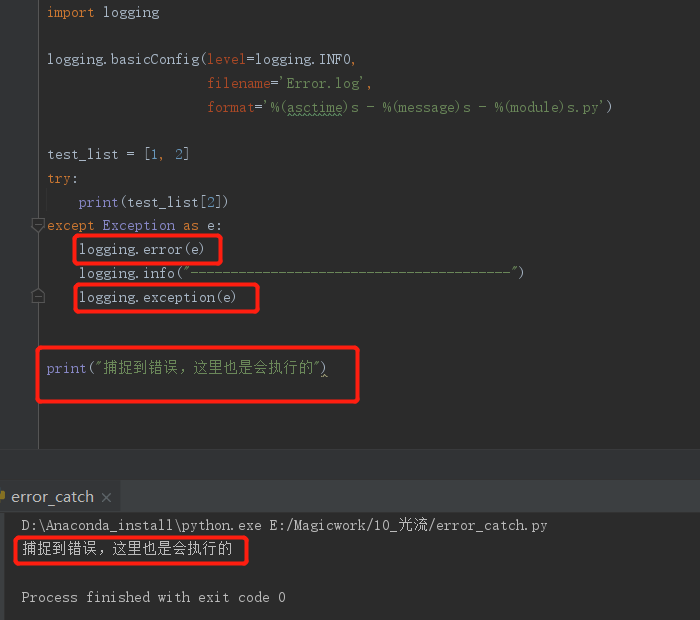
在日志中保存捕捉的异常信息,Error.log 中保存的异常信息如下:
从日志内容可以看出:
logging.error(): 输出的是简短的异常信息logging.exception():输出的是详细的异常信息

五、常用的异常类型表
| 异常 | 描述 |
|---|---|
| BaseException | 所有异常的基类 |
| SystemExit | 解释器请求退出 |
| KeyboardInterrupt | 用户中断执行(通常是输入^C) |
| Exception | 常规错误的基类 |
| StopIteration | 迭代器没有更多的值 |
| GeneratorExit | 生成器(generator)发生异常来通知退出 |
| StandardError | 所有的内建标准异常的基类 |
| ArithmeticError | 所有数值计算错误的基类 |
| FloatingPointError | 浮点计算错误 |
| OverflowError | 数值运算超出最大限制 |
| ZeroDivisionError | 除(或取模)零 (所有数据类型) |
| AssertionError | 断言语句失败 |
| AttributeError | 对象没有这个属性 |
| EOFError | 没有内建输入,到达EOF 标记 |
| EnvironmentError | 操作系统错误的基类 |
| IOError | 输入/输出操作失败 |
| OSError | 操作系统错误 |
| WindowsError | 系统调用失败 |
| ImportError | 导入模块/对象失败 |
| LookupError | 无效数据查询的基类 |
| IndexError | 序列中没有此索引(index) |
| KeyError | 映射中没有这个键 |
| MemoryError | 内存溢出错误(对于Python 解释器不是致命的) |
| NameError | 未声明/初始化对象 (没有属性) |
| UnboundLocalError | 访问未初始化的本地变量 |
| ReferenceError | 弱引用(Weak reference)试图访问已经垃圾回收了的对象 |
| RuntimeError | 一般的运行时错误 |
| NotImplementedError | 尚未实现的方法 |
| SyntaxError | Python 语法错误 |
| IndentationError | 缩进错误 |
| TabError | Tab 和空格混用 |
| SystemError | 一般的解释器系统错误 |
| TypeError | 对类型无效的操作 |
| ValueError | 传入无效的参数 |
| UnicodeError | Unicode 相关的错误 |
| UnicodeDecodeError | Unicode 解码时的错误 |
| UnicodeEncodeError | Unicode 编码时错误 |
| UnicodeTranslateError | Unicode 转换时错误 |
| Warning | 警告的基类 |
| DeprecationWarning | 关于被弃用的特征的警告 |
| FutureWarning | 关于构造将来语义会有改变的警告 |
| OverflowWarning | 旧的关于自动提升为长整型(long)的警告 |
| PendingDeprecationWarning | 关于特性将会被废弃的警告 |
| RuntimeWarning | 可疑的运行时行为(runtime behavior)的警告 |
| SyntaxWarning | 可疑的语法的警告 |
| UserWarning | 用户代码生成的警告 |
| Exception类:是通用异常基类下列异常类均继承于Exception类,Python解析器会自动将通用异常类型名称放在内建命名空间中,所以当使用通用异常类型时,不需要import exceptions模块。 |
参考:
1、https://blog.csdn.net/zong596568821xp/article/details/78180229
2、http://www.runoob.com/python/python-exceptions.html



♠ ⊕ ♠ ⊕ ♠ ⊕ ♠ ⊕ ♠ ⊕ ♠ ⊕ ♠ ⊕ ♠ ⊕ ♠ ⊕ ♠ ⊕ ♠ ⊕ ♠ ⊕ ♠ ⊕ ♠ ⊕ ♠ ⊕ ♠ ⊕ ♠ ⊕ ♠ ⊕ ♠ ⊕ ♠ ⊕ ♠ ⊕ ♠ ⊕ ♠ ⊕ ♠ ⊕ ♠ ⊕ ♠ ⊕ ♠ ⊕ ♠ ⊕ ♠ ⊕ ♠ ⊕ ♠
最后
以上就是粗暴高山最近收集整理的关于Python的try... excep异常捕捉机制一、没有加入异常捕捉机制二、加入try … except 异常捕捉三、try … except … else … finally 使用四、logging模块调用异常捕捉方法,保存异常信息日志五、常用的异常类型表的全部内容,更多相关Python的try...内容请搜索靠谱客的其他文章。








发表评论 取消回复